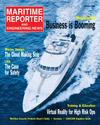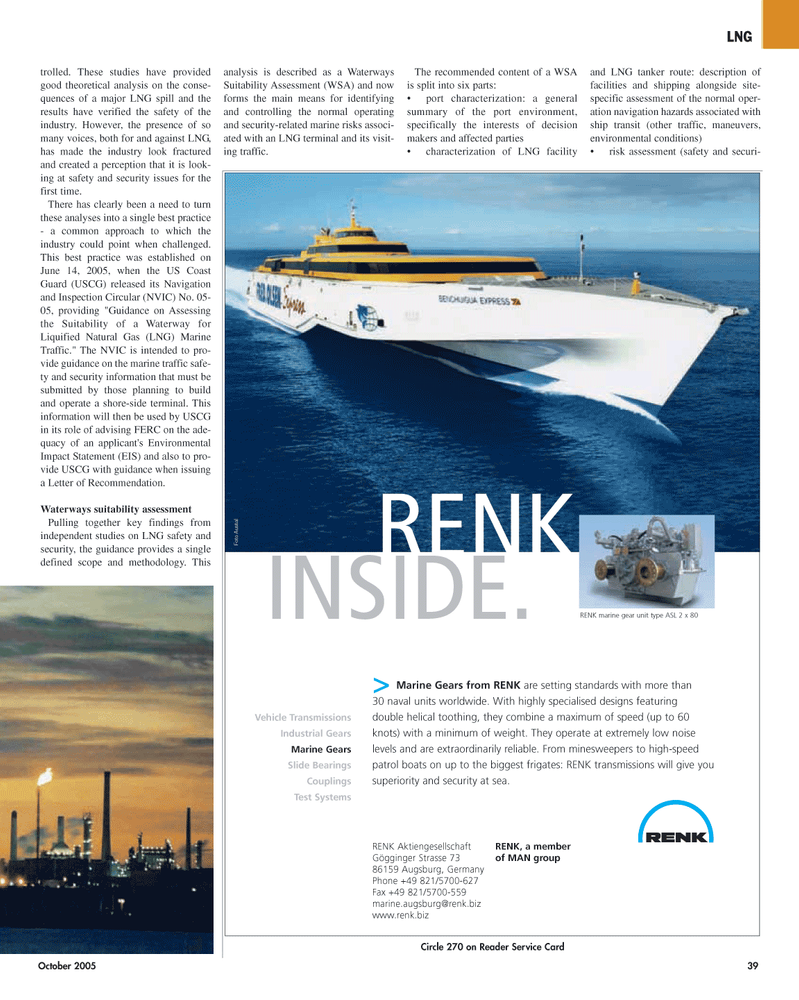
Page 39: of Maritime Reporter Magazine (October 2005)
The Marine Design Annual
Read this page in Pdf, Flash or Html5 edition of October 2005 Maritime Reporter Magazine
October 2005 39 trolled. These studies have provided good theoretical analysis on the conse- quences of a major LNG spill and the results have verified the safety of the industry. However, the presence of so many voices, both for and against LNG, has made the industry look fractured and created a perception that it is look- ing at safety and security issues for the first time.
There has clearly been a need to turn these analyses into a single best practice - a common approach to which the industry could point when challenged.
This best practice was established on
June 14, 2005, when the US Coast
Guard (USCG) released its Navigation and Inspection Circular (NVIC) No. 05- 05, providing "Guidance on Assessing the Suitability of a Waterway for
Liquified Natural Gas (LNG) Marine
Traffic." The NVIC is intended to pro- vide guidance on the marine traffic safe- ty and security information that must be submitted by those planning to build and operate a shore-side terminal. This information will then be used by USCG in its role of advising FERC on the ade- quacy of an applicant's Environmental
Impact Statement (EIS) and also to pro- vide USCG with guidance when issuing a Letter of Recommendation.
Waterways suitability assessment
Pulling together key findings from independent studies on LNG safety and security, the guidance provides a single defined scope and methodology. This analysis is described as a Waterways
Suitability Assessment (WSA) and now forms the main means for identifying and controlling the normal operating and security-related marine risks associ- ated with an LNG terminal and its visit- ing traffic.
The recommended content of a WSA is split into six parts: • port characterization: a general summary of the port environment, specifically the interests of decision makers and affected parties characterization of LNG facility and LNG tanker route: description of facilities and shipping alongside site- specific assessment of the normal oper- ation navigation hazards associated with ship transit (other traffic, maneuvers, environmental conditions) risk assessment (safety and securi- >
Marine Gears from RENK are setting standards with more than 30 naval units worldwide. With highly specialised designs featuring double helical toothing, they combine a maximum of speed (up to 60 knots) with a minimum of weight. They operate at extremely low noise levels and are extraordinarily reliable. From minesweepers to high-speed patrol boats on up to the biggest frigates: RENK transmissions will give you superiority and security at sea.
RENK Aktiengesellschaft
Gögginger Strasse 73 86159 Augsburg, Germany
Phone +49 821/5700-627
Fax +49 821/5700-559 [email protected] www.renk.biz
RENK, a member of MAN group
Vehicle Transmissions
Industrial Gears
Marine Gears
Slide Bearings
Couplings
Test Systems
RENK
INSIDE.
RENK marine gear unit type ASL 2 x 80
Foto
Austal
Circle 270 on Reader Service Card
LNG
MR OCTOBER 2005 #5 (33-40).qxd 9/29/2005 8:20 AM Page 39

 38
38

 40
40
